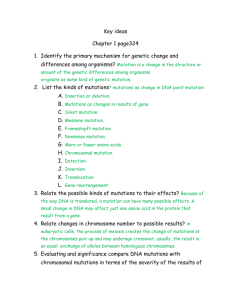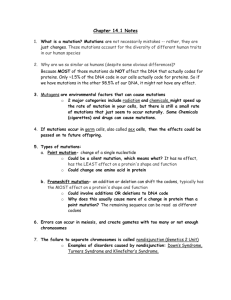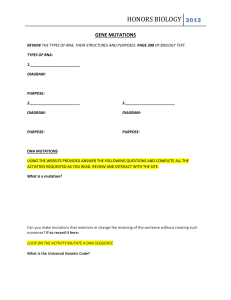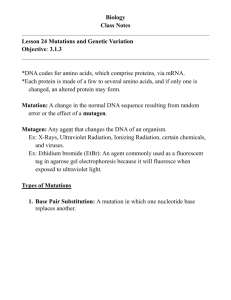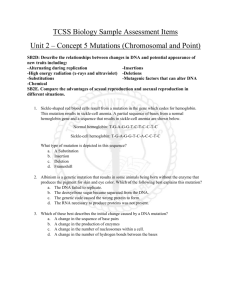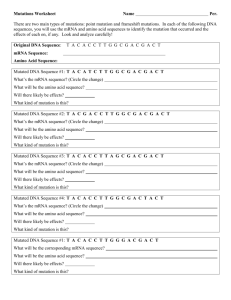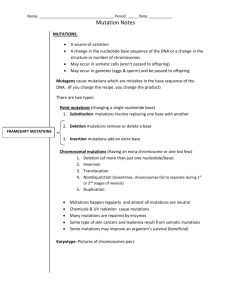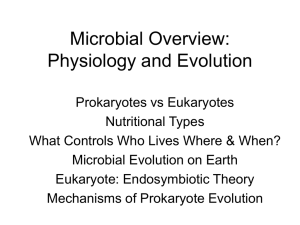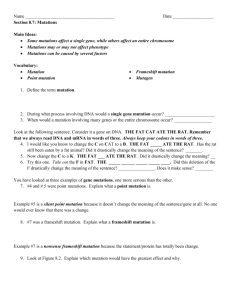Mutation and DNA
advertisement
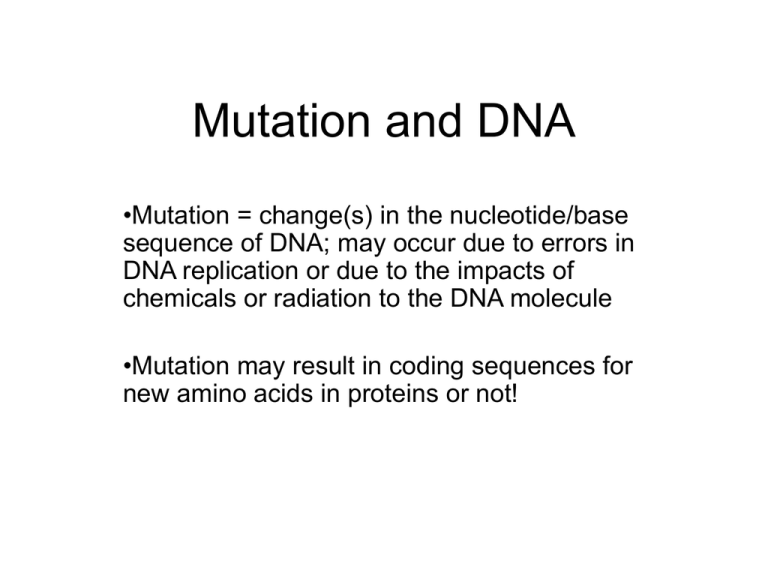
Mutation and DNA •Mutation = change(s) in the nucleotide/base sequence of DNA; may occur due to errors in DNA replication or due to the impacts of chemicals or radiation to the DNA molecule •Mutation may result in coding sequences for new amino acids in proteins or not! 1. Point mutations affect single sites on DNA • Substitution of 1 base for another • Deletion/addition of a single base • Deletion/addition of a small number of bases • If purine (A/G) or pyrimidine (T/C) substitutes for itself = transition substitution • If purine substitutes for pyrimidine or vice versa = transversion substitution Results of point mutations • Silent mutations = due to redundancy of the Genetic Code, most point mutations are silent – do not code for a different amino acid • Missense mutations = produces change in amino acid in protein but does not change the function of the protein • Nonsense mutations = produces a STOP codon in the midst of the mRNA transcript; can produce a non-functional protein Sample outcome of DNA code Methionine, proline, threonine, arginine, stop Silent mutation Due to redundancy of Genetic Code, no change in amino acid sequence is produced!! Missense mutation Missense mutation produces a change in amino acid sequence in protein product (Histidine in for Arginine); may change function of protein or may not! Nonsense mutation Bad news! – nonsense mutation produces a STOP codon within the mRNA transcript leading to a truncated protein. How short the protein product depends on where the STOP codon was produced within the mRNA transcript. 2. Chromosomal mutations change the structure of whole chromosomes • Chromosomal mutations are more extensive, altering the entire chromosomal structure • These kinds of mutations occur through: • • • • Deletions Duplications Inversions Translocations Deletions to chromosome If too much information is lost, it may be fatal to the organism and may result in early death (e.g., Cri-du-chat syndrome – large deletion from chromosome #5) Duplications within chromosome Effect of base duplications depend on location within the chromosome – whether or not duplication resides in coding or noncoding region of DNA Inversions within chromosome Translocations within chromosome Can be caused due to abnormal synapsis event at Meiosis I by incorrect chromosomes coming together. Associated with 2 forms of leukemia – oncogenes translocated to incorrect regions within chromosomes of leukocytes (white blood cells) Mutation is important for evolution • If no changes to genomes occur over time, there would be no evolution – Too much change in the DNA is harmful – Too little does nothing – A balance exists between the amount of new variation and the overall health (adaptiveness) of the new variant individual • Differences between closely related organisms show closely matched DNA sequences that diverged at some past time and that was adaptive for a given environment Our understanding of genes changes with new information • G. Mendel followed traits caused by single gene pairs • T.H.Morgan mapped locations of genes on chromosomes • Jacob and Monod modelled “1 gene, 1 polypeptide” • Later, it was found some DNA coded for only RNA (e.g., rRNA and tRNA) • Some DNA expresses regulatory genes in some people and the same DNA may not express in others • To understand the nature of genes, we must consider their molecular structure (genotype) as well as their phenotypic expression

